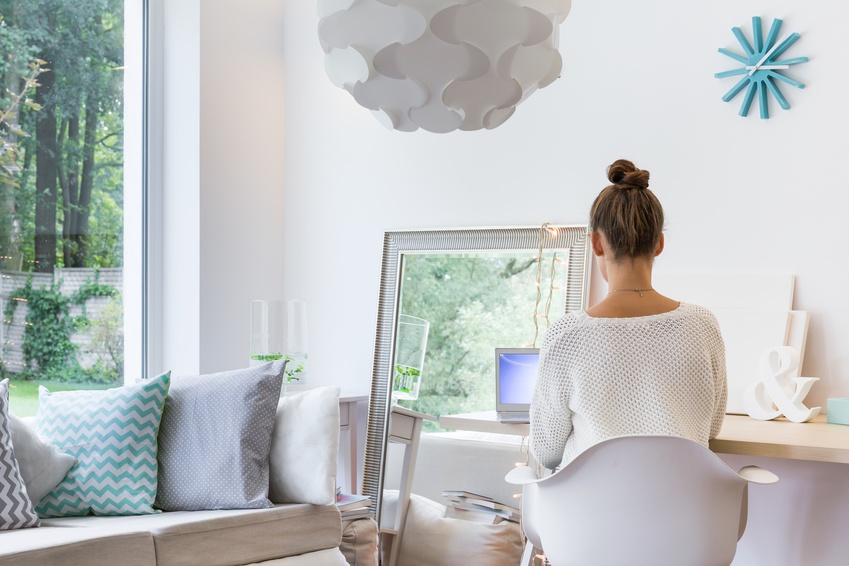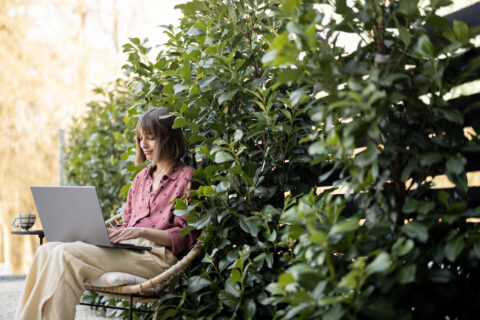With the rising trend in remote working and distributed teams many entrepreneurs and their team members find the prospect of having a home office exciting.
A home office can offer great comfort and efficiency, but without good architecture and design, your home office might not be conducive to productivity.
Here’s a look at 6 essential factors to consider to ensure you’ve crafted a well-designed home office space.
1. Design a home office with workflow in mind.
Make sure your home office is conducive to productivity; specifically for the type of work that you do. Ask yourself these questions:
-
Will the space be used for collaborating with co-founders and colleagues?
-
Will clients, suppliers, and/or vendors be visiting?
-
What type of equipment will you be using in daily operations?
-
What time of the day will you be occupying your home office?
-
Will you be video conferencing to stay connected?
Your home office design should make your work easier. It is important to establish the purpose of the office and your processes before planning the design.
2. Every home office needs good lighting.
Good lighting is essential in any office. Ensure a good balance of natural daylight and task lighting. Generally it is ideal to let in as much natural daylight as possible. The amount of daylight that can enter into your office space will depend on your geographical location, the orientation of your house, and window placement and size.
If your home office is not optimized for these factors, an architect can help you make adjustments to your space and give you advice on lighting options. Consider using task lighting fixtures that have dimmer switches so that you can control lighting levels when you are not relying on daylight.
3. Leverage ergonomics to avoid home office fatigue.
Ensure your office is designed to keep your body comfortable and healthy while you work. “The goal of office ergonomics is to set up your office work space so that it fits you and the job you are doing.” These days it makes sense to collaborate with an architect or designer on the placement of light sources, storage spaces, equipment and furniture for a smooth workflow.
Plan for the equipment and fixtures you will be using in the space, with efficiency being your objective. Ideally, your office should only have items that you will use everyday. Decide whether you need a compact and portable laptop that you can place anywhere in your office or a powerful desktop computer that will stay in one place. Also, determine the right height for your desk, chairs, and shelves.
4. Consider privacy based designs for your home office .
Privacy is an important aspect of any workspace. It is especially important in a home office, since it is more exposed to potential distractions. Factors such as your house floor plan and the materials of your walls can affect the degree of privacy.
Consider the best placement of your home office and the ideal materials to keep your office quiet and distraction-free. Also, keep in mind that too much privacy can make you feel isolated too, which can negatively impact your work.
5. Make your home office more sustainable.
Architects and designers highly recommend keeping your office space as sustainable as possible, not only to help the planet, but also to help you save in the long run on energy bills.
Making use of natural light and good insulation techniques can help make your office and your home more energy-efficient. You may want to use energy-efficient lighting for your office. Also, consider using sustainable building materials for your office and your office furniture.
6. Paint your home office to boost productivity.
Have you considered the psychological effects of color in a space? “White walls in a room might feel crisp and clean, like a blank slate, but if they’re in your workplace, it’s time to repaint. Color not only affects a person’s mood, but it can also hinder a worker’s effectiveness.”
It is generally safe to use neutral colors for walls, as they do not distract and can bring out accent colours and finishes. “There’s another benefit to being surrounded by soft neutrals: Less eyestrain. ‘For work spaces, neutrals and softer, more grayed hues are better for concentration and preventing eye fatigue,’ says Jackie Jordan, Director of Color Marketing for Sherwin-Williams.”
With all these home office design factors in mind, make sure you enjoy working in your new space and that it reflects your personality. It is also healthy to ensure you have access to sources of momentary de-stressing, whether it is as simple as having a family photo of your desk or as complex as having your windows overlook a view of lush greenery. If you have to work with a professional to achieve your ideal office bliss, go for it. Your productivity and comfort are worth it.
This article has been edited and condensed.
Angelica Mercader writes for Superdraft, a team of experienced Archiects, Building Designers, and Draftsmen who provide Architecture Services in all major Australian cities. Much of her published work about architectural trends and design strategy can be read on the Superdraft blog and Productive Magazine. She is often seen doting on her daughter, reading and re-reading science fiction novels, and solving Sudoku puzzles.
© YFS Magazine. All Rights Reserved. Copying prohibited. All material is protected by U.S. and international copyright laws. Unauthorized reproduction or distribution of this material is prohibited. Sharing of this material under Attribution-NonCommercial-NoDerivatives 4.0 International terms, listed here, is permitted.





